J
James Brodie
Guest
Hyundai has launched the new Tucson PHEV in the UK. It’s priced from £39,330 and joins the SUV’s existing range of 48-volt mild-hybrid and full hybrid variants.
Hyundai has pushed the Tucson further upmarket for its fourth generation, giving it a bold redesign and a host of new technology, making it a more rounded competitor for the Volkswagen Tiguan and the Mazda CX-5 - and this PHEV is key, as more electrical assistance could help further boost refinement.
The Tucson PHEV range is separated into two trim-levels: Premium and Ultimate. Standard equipment for the former includes 18-inch alloy wheels, LED headlamps, keyless go and privacy glass.
This family SUV also features plenty of standard safety equipment, including forward collision avoidance assist, lane-keeping assist, downhill brake control, Isofix points for the two outer rear seats and a new centre airbag which Hyundai says prevents the two front occupants clashing heads in the event of a heavy side impact.
Premium trim also features dual-zone climate control, an eight-speaker audio system, a leather steering wheel and two 10.25-inch screens; one for the infotainment and one for the gauge cluster. There’s also a handful of convenience items, such as a wireless smartphone charger and a rear-view camera.
The range-topping Tucson Ultimate is priced from £42,030 and adds 19-inch alloy wheels, a panoramic glass sunroof and a power-operated tailgate. The cabin gets a lift, too, with leather upholstery, three-zone climate control, extra LED lighting and electrically adjustable front seats with heating and ventilation.

image
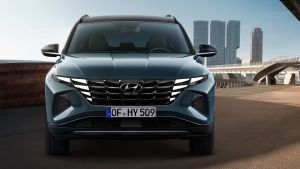
image
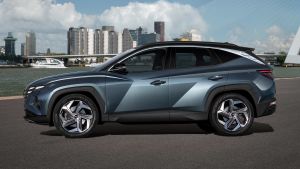
image
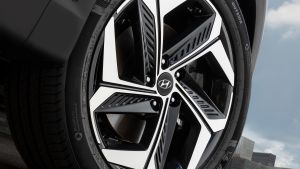
image
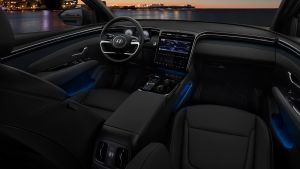
image
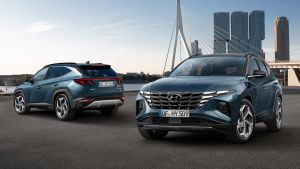
image
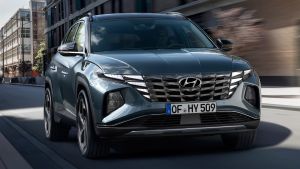
image
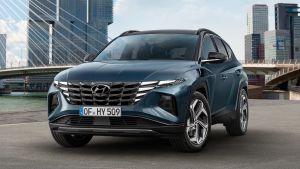
image
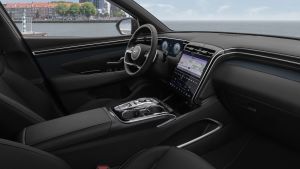
image
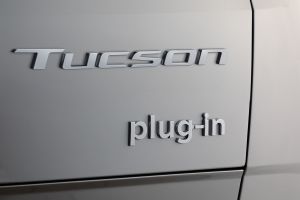
image

image

image

image
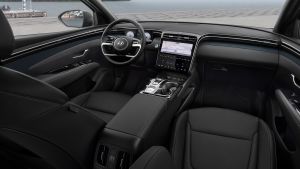
image
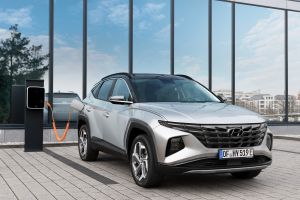
Hyundai Tucson PHEV
Tucson Ultimate buyers can also specify Hyundai’s £1,500 Tech Pack, which adds remote smart parking assist, electronically controlled suspension, blind spot monitoring and a 360-degree parking camera.
New 2021 Hyundai Tucson: engines and drivetrains
The Hyundai Tucson’s PHEV powertrain comprises a 1.6-litre turbocharged four-cylinder petrol engine, a 13.8kWh battery and a 90bhp electric motor. The system sends drive to all four wheels via a six-speed automatic transmission and delivers a combined output of 261bhp and 350Nm of torque.
Hyundai hasn’t yet stated the Tucson PHEV’s fuel economy and emissions output, although the company has announced that the SUV’s battery will provide a maximum electric range of 31 miles between charges.
A 7.2kW on board charger means the battery should take around two hours to charge using a wallbox.
The brand is also keen to stress that the battery is mounted under the vehicle, which has minimised any impact to cabin and boot space. The new Tucson’s boot is nine per cent larger than the old model’s, at 558 litres. With the rear seats folded down this swells to 1,737 litres, which is a 15 per cent improvement over the old car.
Hyundai also offers the same 1.6-litre engine on the entry-level car, albeit stripped of any electrical assistance and mated to a six-speed manual gearbox. On the base-model, it has an output of 148bhp and is available with either front- or four-wheel drive, with the cheapest variant priced from £28,495.

image

image

image

image

image

image

image

image

image

image

image

image

image

image

Hyundai Tucson PHEV
Two 48-volt mild-hybrids are also available, both based around an electrified petrol engine that’s the same as the rest of Tucson line-up’s combustion unit. Prices for the cheaper 148bhp model start at £29,235, while the 178bhp variant has a starting price of £37,380, as it’s only available in top-spec Ultimate trim-level.
Both powertrains come as standard with Hyundai’s new six-speed Intelligent Manual Transmission, a manual gearbox with an electronic linkage between the clutch pedal and the clutch. A 134bhp 48-volt diesel has been announced, too, but it won’t be coming to the UK.
Hyundai also offers a full hybrid version of the Tucson, priced from £32,255. That model combines the 1.6-litre petrol engine with a 59bhp electric motor and a small 1.49kWh battery pack for a combined output of 227bhp and 350Nm of torque, which delivers claimed emissions of 127g/km of CO2.
New 2021 Hyundai Tucson: design and interior
The fourth-generation Hyundai Tucson has undergone a complete rethink inside and out, introducing a new and distinctive design language. Combined with some key technology updates, it’s part of Hyundai’s plan to push its SUV further upmarket.
Hyundai previewed the new Tucson in late 2019 with the bold-looking Vision T concept. The production version features many of the concept’s styling cues. The Tucson’s front end is dominated by a new grille, with integrated LED running lights.
The new SUV’s flanks are more sculpted, with dramatic creases, bold shoulders, squared-off wheel arches and a sweeping chrome trim line flowing in one arc from the car’s A-pillar to the C-pillar.

image

image

image

image

image

image

image

image

image

image

image

image

image

image

Hyundai Tucson PHEV
The tailgate sports a new full-width LED light bar with claw-like elements, with the unit’s lighting signature following a similar pattern to the front grille, which is also repeated on the rugged-looking lower bumper section. The rear wiper blade is hidden under the spoiler, to make the tailgate’s surface as smooth as possible.
The comprehensive transformation continues with an all-new interior; the dash is set low to increase forward visibility, and the design is defined by two chrome lines that sweep seamlessly around the doors, across the top of the dash and then flow downwards into a new, higher centre console.
Hyundai says it has made improvements in material quality with the use of more soft-touch plastics, while buyers will have the option of black or black-and-beige upholstery in leather or fabric, alongside a contrasting black-and-teal package. Drivers get a 64-colour ambient lighting system to play with, too.
New 2021 Hyundai Tucson: technology and infotainment
Along with the usual Apple CarPlay and Android Auto support, Hyundai’s new dual-screen 10.25-inch infotainment setup adds a host of features, including Google and Apple Calendar integration, as well as selectable user profiles.
Last-mile navigation is another new feature, meaning if the driver can’t park at their precise destination, further directions will be sent to their smartphone for finishing the journey on foot. Live parking and traffic information is also part of the new navigation package.
Finally, Hyundai has introduced a host of new driver-assistance and safety features, the most important being the brand’s semi-autonomous Highway Drive Assist system. It comes as standard on the range-topping Tucson Ultimate.
The system can brake and accelerate automatically to keep a pre-set distance from other vehicles, while using Lane Follow Assist to keep the Tucson in lane on motorways and dual carriageways. Remote Smart Parking Assist is another new automated feature, which means the car can be summoned from a parking spot via a button on the key fob.
What are the best crossovers on sale right now? Click on our gallery below to find out...
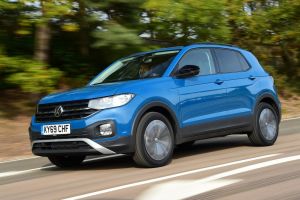
VW brings added kudos to the small SUV field.
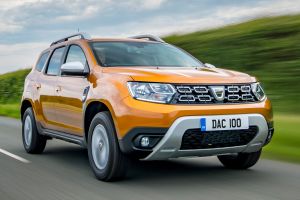
Lacks the latest tech, but space and price are hard to beat.

Clio based small SUV has plenty of equipment and rides well.
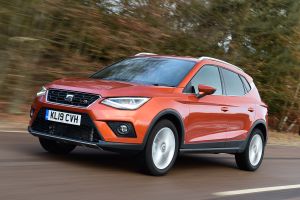
Oldest of the MQB- based SUVs but still a solid choice.
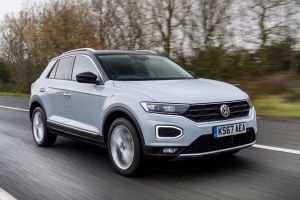
Golf based T-Roc is refined and has more space than T-Cross

Fiesta underpinnings means the Puma is fun-to-drive.
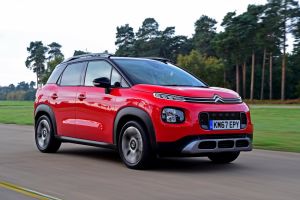
Suspension and seating are both comfort biased.
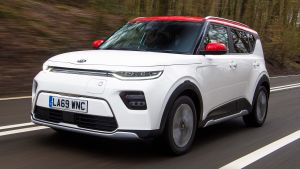
Kia Soul EV offers a quirky design, but remains brilliantly capable
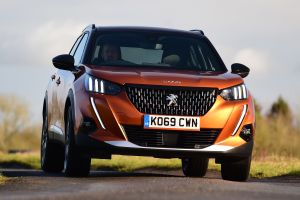
Planted and with precise handling, the 208 offers a comfortable rid
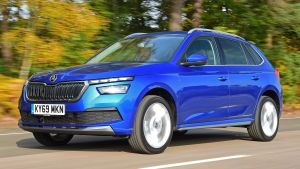
Practical, good value and decent to drive, Kamiq is hard to beat.
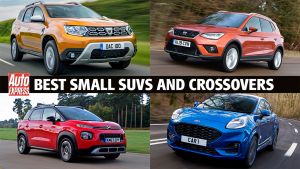
Best small SUVS
Continue reading...
Hyundai has pushed the Tucson further upmarket for its fourth generation, giving it a bold redesign and a host of new technology, making it a more rounded competitor for the Volkswagen Tiguan and the Mazda CX-5 - and this PHEV is key, as more electrical assistance could help further boost refinement.
- SEE MORE Hyundai Tucson vs Lexus NX
The Tucson PHEV range is separated into two trim-levels: Premium and Ultimate. Standard equipment for the former includes 18-inch alloy wheels, LED headlamps, keyless go and privacy glass.
This family SUV also features plenty of standard safety equipment, including forward collision avoidance assist, lane-keeping assist, downhill brake control, Isofix points for the two outer rear seats and a new centre airbag which Hyundai says prevents the two front occupants clashing heads in the event of a heavy side impact.
Premium trim also features dual-zone climate control, an eight-speaker audio system, a leather steering wheel and two 10.25-inch screens; one for the infotainment and one for the gauge cluster. There’s also a handful of convenience items, such as a wireless smartphone charger and a rear-view camera.
The range-topping Tucson Ultimate is priced from £42,030 and adds 19-inch alloy wheels, a panoramic glass sunroof and a power-operated tailgate. The cabin gets a lift, too, with leather upholstery, three-zone climate control, extra LED lighting and electrically adjustable front seats with heating and ventilation.

image

image

image

image

image

image

image

image

image

image

image

image

image

image

Hyundai Tucson PHEV
Tucson Ultimate buyers can also specify Hyundai’s £1,500 Tech Pack, which adds remote smart parking assist, electronically controlled suspension, blind spot monitoring and a 360-degree parking camera.
New 2021 Hyundai Tucson: engines and drivetrains
The Hyundai Tucson’s PHEV powertrain comprises a 1.6-litre turbocharged four-cylinder petrol engine, a 13.8kWh battery and a 90bhp electric motor. The system sends drive to all four wheels via a six-speed automatic transmission and delivers a combined output of 261bhp and 350Nm of torque.
Hyundai hasn’t yet stated the Tucson PHEV’s fuel economy and emissions output, although the company has announced that the SUV’s battery will provide a maximum electric range of 31 miles between charges.
A 7.2kW on board charger means the battery should take around two hours to charge using a wallbox.
The brand is also keen to stress that the battery is mounted under the vehicle, which has minimised any impact to cabin and boot space. The new Tucson’s boot is nine per cent larger than the old model’s, at 558 litres. With the rear seats folded down this swells to 1,737 litres, which is a 15 per cent improvement over the old car.
Hyundai also offers the same 1.6-litre engine on the entry-level car, albeit stripped of any electrical assistance and mated to a six-speed manual gearbox. On the base-model, it has an output of 148bhp and is available with either front- or four-wheel drive, with the cheapest variant priced from £28,495.

image

image

image

image

image

image

image

image

image

image

image

image

image

image

Hyundai Tucson PHEV
Two 48-volt mild-hybrids are also available, both based around an electrified petrol engine that’s the same as the rest of Tucson line-up’s combustion unit. Prices for the cheaper 148bhp model start at £29,235, while the 178bhp variant has a starting price of £37,380, as it’s only available in top-spec Ultimate trim-level.
Both powertrains come as standard with Hyundai’s new six-speed Intelligent Manual Transmission, a manual gearbox with an electronic linkage between the clutch pedal and the clutch. A 134bhp 48-volt diesel has been announced, too, but it won’t be coming to the UK.
Hyundai also offers a full hybrid version of the Tucson, priced from £32,255. That model combines the 1.6-litre petrol engine with a 59bhp electric motor and a small 1.49kWh battery pack for a combined output of 227bhp and 350Nm of torque, which delivers claimed emissions of 127g/km of CO2.
New 2021 Hyundai Tucson: design and interior
The fourth-generation Hyundai Tucson has undergone a complete rethink inside and out, introducing a new and distinctive design language. Combined with some key technology updates, it’s part of Hyundai’s plan to push its SUV further upmarket.
Hyundai previewed the new Tucson in late 2019 with the bold-looking Vision T concept. The production version features many of the concept’s styling cues. The Tucson’s front end is dominated by a new grille, with integrated LED running lights.
The new SUV’s flanks are more sculpted, with dramatic creases, bold shoulders, squared-off wheel arches and a sweeping chrome trim line flowing in one arc from the car’s A-pillar to the C-pillar.

image

image

image

image

image

image

image

image

image

image

image

image

image

image

Hyundai Tucson PHEV
The tailgate sports a new full-width LED light bar with claw-like elements, with the unit’s lighting signature following a similar pattern to the front grille, which is also repeated on the rugged-looking lower bumper section. The rear wiper blade is hidden under the spoiler, to make the tailgate’s surface as smooth as possible.
The comprehensive transformation continues with an all-new interior; the dash is set low to increase forward visibility, and the design is defined by two chrome lines that sweep seamlessly around the doors, across the top of the dash and then flow downwards into a new, higher centre console.
Hyundai says it has made improvements in material quality with the use of more soft-touch plastics, while buyers will have the option of black or black-and-beige upholstery in leather or fabric, alongside a contrasting black-and-teal package. Drivers get a 64-colour ambient lighting system to play with, too.
New 2021 Hyundai Tucson: technology and infotainment
Along with the usual Apple CarPlay and Android Auto support, Hyundai’s new dual-screen 10.25-inch infotainment setup adds a host of features, including Google and Apple Calendar integration, as well as selectable user profiles.
Last-mile navigation is another new feature, meaning if the driver can’t park at their precise destination, further directions will be sent to their smartphone for finishing the journey on foot. Live parking and traffic information is also part of the new navigation package.
Finally, Hyundai has introduced a host of new driver-assistance and safety features, the most important being the brand’s semi-autonomous Highway Drive Assist system. It comes as standard on the range-topping Tucson Ultimate.
The system can brake and accelerate automatically to keep a pre-set distance from other vehicles, while using Lane Follow Assist to keep the Tucson in lane on motorways and dual carriageways. Remote Smart Parking Assist is another new automated feature, which means the car can be summoned from a parking spot via a button on the key fob.
What are the best crossovers on sale right now? Click on our gallery below to find out...

VW brings added kudos to the small SUV field.

Lacks the latest tech, but space and price are hard to beat.

Clio based small SUV has plenty of equipment and rides well.

Oldest of the MQB- based SUVs but still a solid choice.

Golf based T-Roc is refined and has more space than T-Cross

Fiesta underpinnings means the Puma is fun-to-drive.

Suspension and seating are both comfort biased.

Kia Soul EV offers a quirky design, but remains brilliantly capable

Planted and with precise handling, the 208 offers a comfortable rid

Practical, good value and decent to drive, Kamiq is hard to beat.

Best small SUVS
Continue reading...
